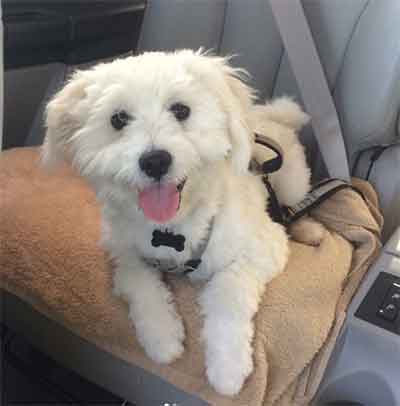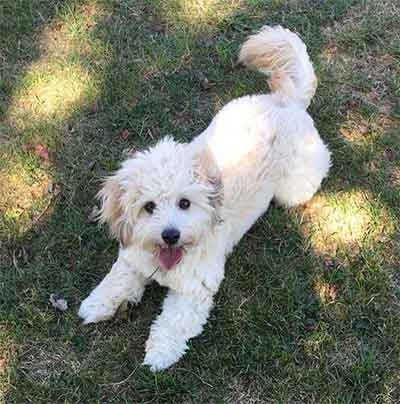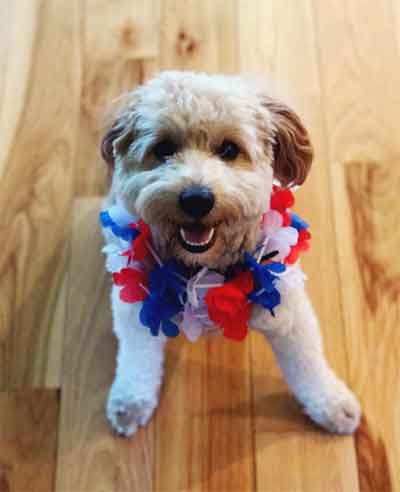Some dogs are bred for their speed and agility, others for intelligence and compatibility as a working dog.
Others are favored for their unusual looks or the quality of their coat.
Hybrid dog breeding allows us to try and create a pet dog, or working dog, with the best qualities of two different breeds. The aims is to either accentuate the positives or tone down the negatives.
The Eskipoo is a great example. This is a hybrid that may not that well known, but it has the potential for some great traits when all the genes fall into the right place.
In this guide to the Eskipoo, we will look at all the important Eskipoo information that all owners need before they decide whether or not to buy/adopt one of these pups from a local breeder.
The main objective here is to look at the main aims with this hybridization, and the potential for success or failure.
This means looking at the pros and cons when it comes to the size of the dog, the coat that is produced and their general behavior.
We will look at the suitability of this dog as an apartment dog, the issues of Eskipoo grooming and potential behavioral and training issues with the Eskipoo temperament.
We will also look at important health issues, such as the Eskipoo lifespan, and offer guidance on buying and adopting these animals.
Before all of that, we need to understand what an Eskipoo actually is.
Table of Contents
So what is an eski poo, and what are we meant to call it?
The Eskipoo is a cross between the Eskimo Dog of North America and the European Poodle.
It is unclear precisely when this cross breed first occurred, but it is assumed that breeders wanted to adapt the Eskimo Dog with new characteristics, such as a more manageable coat, better personality or smaller size.
Eskipoo is the most common name for this new hybrid, with occasional variations in spelling depending upon who you talk to – such as Eskapoo.
It is also known as a Pookimo to some – the alternative switch on the portmanteau name – although Eskipoo is more recognizable and sounds a little less like a Pokemon character. Either way, these are the pups of the Eskimo Dog and the Poodle.
 Eskipoo Puppy – Image Source
Eskipoo Puppy – Image Source
Why breed these two dogs?
So let’s look at those three changes that breeders hope to create with this new Eskimo Dog Poodle cross.
The first is that idea of a more manageable coat. Coat types can vary with these dogs. They can be long and thick like an Eskimo Dog, curly like a Poodle or a bit of both.
There are also different colors of coat include white and creams, through to browns and blacks. The most common colors are likely to be white, because so many of these Spitz dogs and so many Poodles have white coats.
However dominant genes from different colored Poodles may play their part in the look of these animals.
The thick coat can also mean that they struggle in high temperatures, so don’t suit all climates.
The grooming needs are moderate here, depending on the coat type. They will require plenty of brushing to keep them in good condition whichever coat type that they have. You don’t want the curls becoming tangled or mats in the thicker, longer coats.
There are understandable concerns with these dogs about Eskipoo shedding because of the blend of the thick coat and that non-shedding Poodle coat.
Many see these as low shedders. There is a likelihood of hypoallergenic fur, but not a guarantee.
What about the Eskipoo size? Is this the small family-friendly dog people hope for?
The next aspect to look at with those main breeding aims is the idea of a smaller dog that is more manageable in the home.
They are smaller dogs than you might expect. The Poodle genes are clear in a number of features with this dog, but they tend to retain the smaller size of their Spitz heritage.
An Eskipoo full grown will weigh between 13-20 pounds and measure 9-15 inches.
This variation in Eskipoo weight and height will depend on the genetic leanings of the dog – if they are more like the Poodle than the Eskimo Dog – and the sex.
These crossed genes also result in other key physical features that you will see in many of these pups. These include the round head, floppy ears and short muzzles.
There is also the potential for blue eyes in the Eskimo Dog genes, but it is not that likely. This is something we will look at further when discussing breeders.
The Eskipoo dog as an apartment dog and family friendly dog
Many owners will agree that this pup is best suited to families with children because of their attitude.
They have a great mixture of affection and energy that is perfect in a family environment, and the gentle side that makes them a little easier to handle.
However, these dogs require plenty of exercise because they are a high energy breed – a good long walk and playtime out in the yard – which is one reason why this apartment sized dog may not actually do so well in an apartment.
Are there any behavioral problems?
This highlights the general idea of a good natured animal with a great temperament.
For the most part, the Eskipoo personality is clearly great and they are lovely dogs to have around when trained well, the problem is that there are potential behavior issues when training goes awry.
There are potential behavioral problems with barking, which could limit their potential as apartment dogs even further. They are built to bark at signs of trouble, so are set off by unusual sounds.
Another problem with this hybrid is separation anxiety. All that love and affection for the family pack means that they want to be with them all the time.
They are not keen to be left alone for long periods, so ideally they will be in a home where this doesn’t happen – such as a couple with one parent at home most of the day that can walk the dog ans stay with it. Couples with full times jobs will not have the time for these dogs.
In addition to this, there are those that notice that there is a bit of an attention seeking streak in some dogs.
What does this mean for Eskipoo training?
These potential issues with the behavior of these dogs means that many owners will feel the need to turn to professional help.
Training is essential from an early age in many areas– notably socialization and separation training. Yet, they are smart dogs so should get the hang of things pretty quickly. Both parent breeds are pretty smart and well behaved, so it should rub off onto their offspring.
Obedience schools are a possibility, if you have the time and money, but could be a little overwhelming for hyperactive barkers. The alternative here is to look at some online courses and e-books, such as Doggy Dan the online dog trainer.
These step by step guides are a great idea for anyone that wants to work in comfort of their own home, at their own pace.
Important health care information
One term that we often hear when it comes to hybrid dogs is hybrid vigor.
This is the idea that all cross breed dogs are naturally healthier than their pure bred parents because there are fewer risks of major hereditary disease. The problem is that there are still issues that slip through.
Also, health depends on the responsibility and care of the breeders during the early stages of the pup’s life.
If the breeder doesn’t undertake the right checks and vaccinations before they sell their pups, there could be issues that they miss.
Always check to see the healthcare paperwork before you buy.
With this hybrid there are potential health problems with eye and dental issues. The latter means that there are warnings about good dental hygiene and their diet. Others develop eye diseases such as retinal dysplasia, glaucoma and corneal ulcers.
The other thing to watch out for here is that the life expectancy is typically between 10 and 12 years. This may come as a surprise to those familiar with the Eskimo Dog as they tend to live between 13 and 15 years.
Looking for Eskipoo puppies for sale
The issues with the health of the pups is not the only reason why you need to be careful when choosing between Eskipoo breeders.
There are some people that dedicate their life and work to this cross breed, understand its needs and can create happy, well-bred lines in a great environment.
Then there are those that know nothing about the cross – or the parents – and simply want to find the next big thing in “designer dogs”.
It pays to do your research with any local breeders. If they don’t seem all that reputable in your town, go further afield.
The prices of these Eskimo Dog x Poodle pups
The cost of these dogs will always vary depending on the breeder, the location and general rules of supply and demand.
If you live in an area where they are popular, but there are few breeders, you may have to pay a little more to get a good, healthy dog.
Some will also charge a little extra if they have what they consider to be a rare form of this dog – such as rarer colors of browns and apricots, or animals with blue eyes.
Beware of these cons. Also beware of those that offer pups on the opposite end of the price scale because they may come from irresponsible breeders with bad living conditions.
Some people are in this for their own profit, with little regard for the animal. You may get a cheaper deal to begin with, but an unhappy animal with health problems and bigger costs to contend with down the line.
What about Eskipoo rescue options?
The chances of eskie poos ending up in rescue shelters is higher than you may imagine because of the issues raised above.
There will be plenty of dog owners that don’t realize just how much time and energy that they have to invest in this cross breed. Their constant need for entertainment, play and affection may be too much, especially if these dogs get stressed and disruptive if left alone.
If you go to a shelter for an Eskipoo pup, you need to understand the personality and needs of the individual dogs and think long and hard about your abilities to meet those needs.
What have we learned about this American Eskimo Poodle mix?
Eskipoo puppies definitely have their pros and cons.
There are plenty of reasons to turn to this cross, as it is clear that this hybrid breeding does add some positive new traits. The coat should be easier to manage if it has that curlier, hypoallergenic gene of the poodle.
It is a small dog that will suit many homes and family set ups. It is also smart, loving and easy to train because of its inherited genes.
However we can’t overlook the fact that there are also a number of negative Eskipoo characteristics that may limit their appeal somewhat.
>> They are not good apartment dogs – even though they are small enough – because of their high energy.
>> They struggle with separation anxiety and attention seeking traits that mean that they also work in family homes with constant attention.
>> They have the potential for other coat types that may be more difficult to handle.
This is why it pays to research the hybrid further, and to pay a visit to all breeders before making a choice. The more informed your decision, the happier you will both be.
Is this Eskipoo right for you?
If you decide to buy a pup, or search for Eskipoo adults in shelters, you still need the same level of commitment towards these affectionate, active dogs.
Owners that have the space and time to dedicate to their new pet, and a loving, respectful family unit, can enjoy many long years with these loving creatures. They can suit the family home well with the right training and attention.
If you are a couple or single owner looking for a low maintenance dog with minimal risks, this Eskimo Poodle mix may not be the best option.
Featured Image: Instagram/oakley_the_eskipoo





